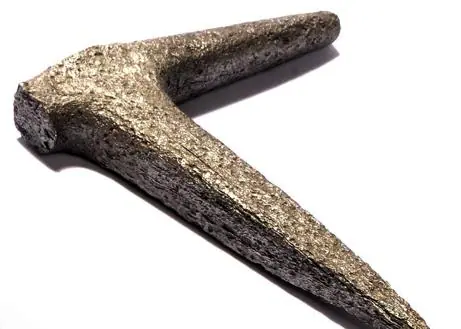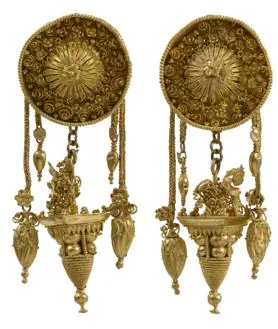It has taken the Benaki Museum seven years to launch the magnificent and ambitious monographic exhibition: ‘Golden art. Goldsmithing in Hellenistic times’which allows the visitor to enter this world in the period that spans from 323 BC, – the year of the death of Alexander the Great – and the annexation of Egypt by Rome in 30 BC
During the investigations carried out within the framework of the exhibition, in which microscopy and imaging techniques have been used experimental archeologyexperts have managed to rigorously analyze dozens of pieces, drawing, among other conclusions, that Hellenistic goldsmiths knew and used the golden ratio in the creation of their works. «Until now it had been documented in other artistic expressions but never in jewelry», says the archaeologist and curator of the exhibition, Irini Papageorgíu, who believes that this discovery changes the way of understanding the working methods of gold artisans in the Hellenistic era.
Renamed in the 16th century as divine proportionthe golden ratio was used by Egyptians, Greeks and Romans to achieve perfection in the work thanks to a nature inspired patternwhere the rectangle is the main protagonist and that achieved the harmonious relationship of all parts of it. During Classical Greece the golden ratio was considered the key to understanding the cosmos and Phidias used it in the sculptural decoration of the Athens Parthenon.
Experimental archeology
Wandering among the more than 500 pieces on display, the visitor will not only be able to contemplate some of the most representative jewels and the tools with which they were made, but, thanks to an experimental archeology project, they will also be able to delve deeper into the manufacturing techniques through several videos that show the results of the exhaustive investigation.


Above, Flowering myrtle wreath from 350-325 BC Below, iron anvil from the Ošanjići treasure next to gold earrings
Furthermore, and for the first time, the pieces have been subjected to an exhaustive microscopic analysis to, thanks to the traces left by the tools during their manufacturing, create similar tools to those used by the Hellenistic master goldsmiths. «The tool reached its final form when it became an extension of the craftsman’s hand. Each goldsmith made his own tools adapted to his pace of work,” explains Akis Gumas, scientific advisor of the exhibition and responsible for the experimental archeology tests carried out.
“We have tried to get closer to the people who made these jewelry, understand them through their tools, their way of working,” adds Papageorgíu. Analyzing the pieces with the microscope has also been revealing because the experts have been able to verify the amount of details that have some pieces and that are not visible to the naked eye. «This leads us to think that, in a time when magnifying lenses did not exist“Touch was the fundamental tool of the goldsmiths,” says Gumas. For this reason, and as a way to reactivate in visitors this sense that is so important for gold artisans, the exhibition has a touch display case where you can touch various types of wires (unworked, stranded and granulated); unworked copper sheets and a finished piece.
Achaemenid gold
With Alexander the Great, the borders of Hellas were extended to the known ends of the world, creating a complex network of kingdoms and cities where miscegenation and population movements generated a constant exchange of knowledge and “a cultural osmosiswhich ended up generating a common artistic language, also evident in jewelry,” adds Papageorgíu.
After the battle of Gaugamela in 331 BC, Alexander the Great seized the royal treasure guarded in the city of Susa; A few years earlier, after the defeat of Issus, he had also seized the treasury of Damascus. The gold of the Achaemenids, in the hands of Alexander the Great, would end up reaching this part of the Mediterranean and, with it, the time of maximum splendor of ancient goldsmithing.
«Gold and jewels, in addition to being a symbol of social statusaccompanied people in different life stages such as the transition to adulthood, marriage, and death. Objects that had apotropaic and religious qualities were also made in gold,” explains Papageorgíu. That is why most of the pieces in the exhibition were found in funerary contextsespecially in children’s and female burials, where jewels were deposited as accompanying objects for the long trip to Hades. Also on display are jewelry found in the main sanctuaries of the country, such as that of Delos, where brides offered their wedding jewelry to the gods, as well as pieces that must have belonged to priests or initiates in the Orphic mysteries.
The owners of the jewels also created a emotional bond with them, as demonstrated by the inscription on a metal plate found on the island of Delos, included among the pieces in the sample and in which the owner of a gold bracelet, invoking all the chthonic divinities, curses the thief who He stole it, wishing that “all the nerves in his body would be paralyzed.” On a more material level, jewelry and gold were also a economic investment which, in times of political instability typical of this period, had to be kept safe: hence the discovery of three treasures, which in all probability were forgotten or lost by their owners in their attempt to save them and which were found by the archaeologists at the sites of Delos, Thebes and Kefalonia that can be seen in the museum.
Reunification of the Karpenisi Treasury
Among the half a thousand pieces belonging to 25 Greek and 5 foreign museums, the exhibition gives the viewer the opportunity to contemplate, for the first time in full he Karpenisi treasure, masterpiece of Hellenistic goldsmithing. Composed of 44 pieces and dated between the 3rd and 2nd centuries BC, it is believed to have belonged to members of the Macedonian court. Some of the pieces are named after Zoila. Since the goldsmiths of this time did not sign their works, archaeologists think that it must have been the name of their owner. The treasure is kept between the National Archaeological Museum of Athens, the institution that houses the vast majority of the pieces, and the Benaki Museum since the Greek collector, Eleni Stathatu, donated it in 1957.
#discover #Hellenistic #goldsmiths #golden #ratio #making #jewelry


